| |
 |
|
Ipswich port has a longer
history than just about any other port in
England, and its dockland area has been populated
longer than any other English town. St Clement,
the patron saint of seafarers, was a perfect
choice of patron for this, the largest of the
dockland churches. The parish has been
inextricably linked with seafarers for over a
thousand years.
Ipswich town centre has twelve medieval churches,
and there are others out in the suburbs, but as
with any industrial town, the changing population
patterns of the last half a century have meant
that some of the parishes ended up with no
resident population. St Clement was always the
largest, poorest and most populous of Ipswich's
parishes. But 20th Century slum clearances and
the taking over of the waterfront by industry led
to the population's decline, and then of course
the industry itself began to disappear. |
By the 1970s, six of the town
centre churches had been declared redundant, and it was a
long, slow grind before reuses were found for many of
them. At the start of the 21st Century, five of them
still stood abandoned and, in some cases, near derelict,
because the presumed 'wholly commercial' reuses had not
emerged. Gradually, the optimism and public finance of
the first decade of the century drew four of these into
community reuses, until at last only St Clement remained.
And yet, St Clement has the finest
setting of all the dockland churches, despite the one-way
system passing within ten metres of its north side. The
road was built over that part of the churchyard which
adjoined the ironworks, which still survives across the
road. Seen from this road, the handsome church is stately
among its great trees. The clutter of small buildings
that have surrounded it for hundreds of years have been
cleared away, opening up a fine view from the west.
Until the 1960s the graveyard was almost completely
enclosed, accessible only by the footpath which still
survives coming from Grimwade Street beside the former
parish hall. Approached along this path, the church is a
secretive giant, rising shyly among the overgrown trees.
The church itself is a fine example of fairly late
perpendicular church-building, with a grand tower and as
magnificent a clerestory as any of the Ipswich churches.
The chancel was the work of that ubiquitous Ipswich
architect Frederick Barnes.
For a long time, the view from the outside has been all
you are able to see. The church was declared redundant in
the early 1970s, and has been closed ever since, the
largest of all Ipswich's redundant churches. In the
1980s, it was the victim of a great deal of vandalism
because of its position, relatively isolated from
mainstream town life. The sheltered south side of the
churchyard in particular became littered with the kind of
things that you wouldn't want your children to pick up.
The church itself became a prop-store for the Wolsey
Theatre, and it was surreal indeed to walk among the
fibre-glass cannons, cardboard grandfather clocks and
Scottish warrior outfits that were stacked high in the
nave and aisles.
The church was left pretty much as it was on the day it
closed, as if the churchwardens had put away the hymn
books and slipped out after that final Evensong. However,
in 1996 a disastrous fire swept though St Clement,
completely destroying the 1880s roof. This was soon
rebuilt, and, combined with a clear-up for the churchyard
came landscaping and a memorial to a famous mariner son
of the parish, Thomas Slade.
The former Suffolk College took on the lease on the
building, but gave notice in 2001 that they would not be
renewing it. The late John Blatchly, of the Ipswich
Historic Churches Trust, told me at the time that there
was a potential commercial user interested in taking it
on in the future, but I thought it unlikely that this
would happen. Visiting it at the time, I found this big
church disarmingly bare, with a slight air of
dereliction.
In fact, the former congregation here kept a weather eye
on it, still opening it up on Historic Churches Bike Ride
day, which was more than could be said for some of the
other redundant Ipswich churches. The redecoration and
rebuilding of the roof after the fire had made it sound,
and it was obvious that it wouldn't be too difficult to
convert the building for an appropriate use - as a
concert space, perhaps, or even for one of the new
evangelical churches. I wondered if even the Catholic
Church might take a look, since they don't possess a
large worship space among their five Ipswich churches,
which are often overcrowded.
Coming back here in 2005, I was pleased to discover that
the interior had been spruced up. The royal arms, which
fortunately survived the fire, are probably the best
example of Ipswich's familiar Charles II sets. These are
different to the others in that they are carved and
gilded rather than being painted on boards or canvas. The
wall beside them above the tower arch is resplendent with
19th Century scroll work. The font, reset by the
Victorians in the westward extension of the south aisle,
is a typical East Anglian rural 15th century font, with
angels on the bowl and lions and wild men around the
stem, giving a rustic air to this corner.
The church suffered considerable blast damage during the
Second World War, only four of the stained glass windows
surviving. After the war, the lost east window was
replaced by a striking depiction of the Ascension by
Abbott & Co of Lancaster, a memorial to a local
doctor killed in the Second World War. The glass on the
south side of the chancel depicting the Nativity and the
Annunciation is by Ward & Hughes, and is good for the
workshop. That of the Presentation in the Temple at the
east end of the south aisle is by Powell Brothers of
Leeds, also good. Ward & Hughes' Transfiguration in
the north aisle is perhaps less good, and the Good
Shepherd window by Ide & Sons of London in the south
aisle is spoilt by the cartoony central figure of Christ.
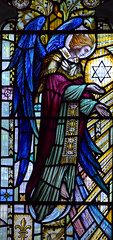 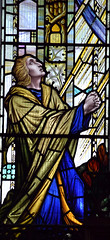 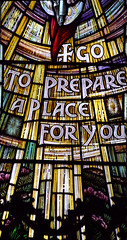  
  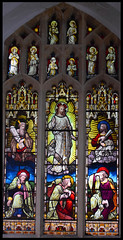  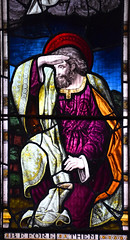
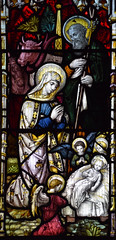 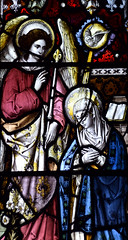  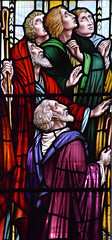 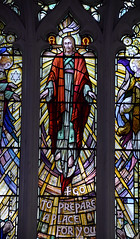 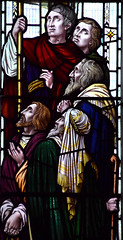
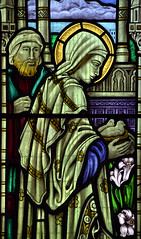 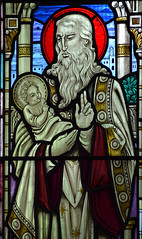 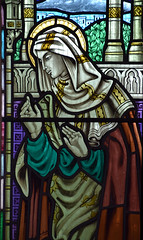   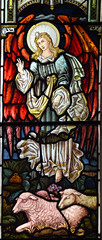
St Clement is remarkable for the
quantity of its memorials, and the quality of some of
them. The best is probably that to John Ward, rector here
throughout the Commonwealth period and beyond the
Restoration. It was reset in the chancel along with a
number of the others by the Victorians, and John Blatchly
credited it to the Danish sculptor Caius Cibber, who was
a great favourite of the English court.
There was an enthusiasm here in the early part of the
20th Century for small memorial plaques, mostly produced
by the Scott & Co Foundry of Ipswich, commemorating
those lost at sea. This extended into the first years of
the Great War, after which the sheer magnitude of losses
seems to have put a stop to the project. The bleak
reredos serves as a parish war memorial, the names of the
lost on a tablet on the west wall.
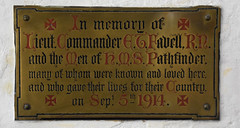 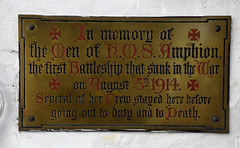 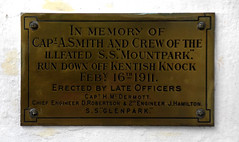 
All too easily, this church could
have been lost to dereliction and vandalism. As it was,
St Clement stood still while Ipswich changed around it.
The 1960s demolition of virtually all of the housing in
the parish that had led to its redundancy was effectively
redressed by the massive Waterfront regeneration, the
almost complete rebuilding of Ipswich's wet dock area. St
Clement now has many new neighbours, and most of them are
residential. St Clement sat and waited, as patiently as
it had done for the previous thirty years, but perhaps
with more hope.
Similarly, the Diocese had moved away from its 1970s
policy of redundancy, and went into the business of
creating benefices, groupings of parishes that shared
ministers and resources. Back in the 1830s, Holy Trinity
a few hundred metres to the east had been built as a
chapel of ease to St Clement. This, in turn, had seeded
St Luke on Cliff Lane. Like St Clement, Holy Trinity had
lost almost all of its parish population, but instead of
being declared redundant it was grouped into a benefice
with St Luke and St Helen on St Helen's Street. For a
time, the benefice took St Clement under its wing again.
The church remained redundant, and was not used for
regular worship, but the benefice used it for events, and
in 2005 the the nave was full of seating, which any
Ipswich resident would have recognised as some of the
chairs formerly in the Corn Exchange.
| And so it went on, St
Clement attracting plenty of attention, but no
permanent reuse. And yet it was clear that this
fine, sound building had a role to play. St
Clement is perfectly suited to the kind of
performance and arts events that its new
neighbours might attract, a community function in
keeping with the proclaimed mission of the
Diocese rather than being reused for what the
Ipswich Historic Churches Trust had hoped would
be 'wholly commercial' purposes. And so it was in 2015 that the
building was chosen as the venue for the long
awaited Ipswich Arts Centre project, designed to
have a similar scale and function to the
Colchester Arts Centre, which is also in a
redundant church. It is hoped that work will
begin in 2018. The involvement of the Borough
Council and the University of Suffolk in the
project leads to the further hope that, after
almost half a century of waiting, the redundant
medieval town centre churches of Ipswich might at
last all have found permanent community reuses.
2020: Unfortunately,
the Ipswich Arts Centre Project seems to have
stalled. Work did not begin in 2018, and the
organisation's website has not been updated since
September of that year.
|
|
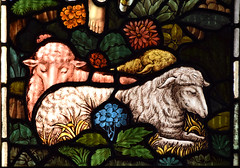 |
|
|

